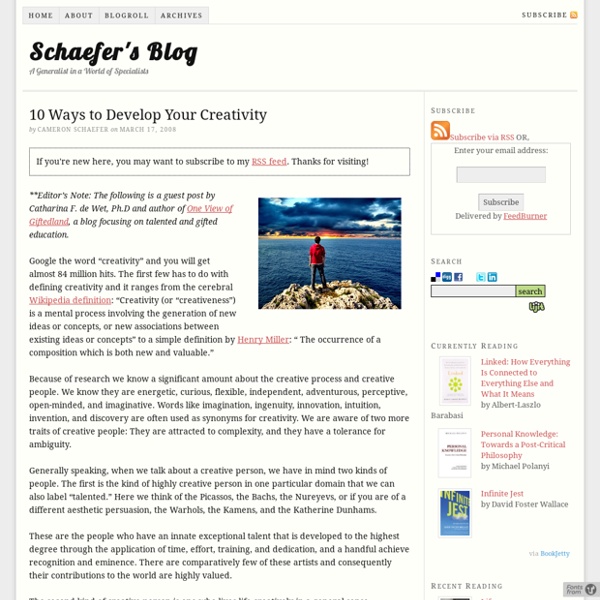Developing Creativity in Every Learner
“Developing Creativity in Every Learner” Library Media Connection, October, 2012 Doug Johnson Creativity has been getting a lot of attention lately. Popular authors Daniel Pink in A Whole New Mind, Richard Florida in The Rise of the Creative Class, and Sir Ken Robinson in The Element all stress that creative ability is essential for both economic and personal fulfillment. The most recent revision of Benjamin Bloom’s popular taxonomy of educational objectives places creativity at the top of the cognitive domain. Every “21st Century Skill” list I’ve seen includes creativity as one of those necessary abilities tomorrow’s most productive workers will need - ISTE’s NET-S and AASL’s Standards for the 21st Century Learner among them. Yet schools aren’t doing a very good job of developing creativity in students. Myth 1. Why do we restrict creativity to the art room and creative writing class when it should be in every class, unit, and activity? Myth 2. Myth 3. Myth 4. Myth 5. Myth 6. Myth 7.
Announcing the Developing Creativity Magazine
My new Developing Creativity Magazine includes articles on creativity research, psychology and personal growth topics, in an interactive format: You can click to “turn” the pages, play videos inside the magazine, zoom viewing size – and more. For this first issue, I have included articles from The Creative Mind archives for October, 2012, so you may have already read them – but you might enjoy the new digital magazine format. Plus, the contents are viewable on an iPhone, iPad and other mobile devices. Contents of issue 1.1: • Creativity Expiration Date? Read Developing Creativity Magazine Issue 1.1 Douglas Eby, MA/Psychology - I am a writer and researcher on the psychology of creativity and personal development, creator of the Talent Development Resources series of sites, and author of the books "Developing Multiple Talents: The personal side of creative expression"; "Being Highly Sensitive and Creative"; and others - see my Résumé.
The Top 10 Ways to Nurture Creativity in Your Children and Yourself
copyright 2003 Kelly Jo Murphy There are many things that you, as a parent, can do to nurture your children’s creativity. Each of the following ways are about you nurturing your children’s creativity, but they can just as easily be used for yourself or the child in you wanting to come out and play! First and foremost is to give her the freedom to think, to feel, to be herself. This can only be when your child feels secure in her environment, when she feels it is OK to be herself. You are your children’s primary role model. Respecting that each child has the right to be herself and believing in her uniqueness builds your child’s confidence in herself. Here are some examples of comments that nurture the creative environment: “It’s fun to try it different ways”“Tell me about it”“Let’s try it anyway”“Have you thought of any alternatives?” These comments focus on having faith in your child and that it is ok to do it HER way. Detach yourself from HER outcome. nterests and passions.
Techniques for creative teaching
Creative teaching In order to teach creativity, one must teach creatively; that is, it will take a great deal of creative effort to bring out the most creative thinking in your classes. Of course, creativity is not the only required element for creative instructors. They must also know their fields and know how to create an appropriate learning environment. When will it be most important for you to offer direct instruction? Because answers to these questions are so diverse — even for individual instructors teaching different courses or at various times of the semester — no one technique will fit all needs. General Techniques These creative thinking techniques were culled from the Internet and summarized by Yao Lu, a graduate student in AESHM (Apparel, Educational Studies, and hospitality Management). Assumption Busting What: An assumption is an unquestioned, assumed truth. Brainstorming How: Define the problem clearly lay out any criteria to be met. Negative (or Reverse) Brainstorming
Chinese Zodiac Year of Snake: Strengths and Weaknesses
Years of the Snake In the Chinese zodiac, the Snake is listed after the Dragon, but its place and its significance as a symbol of worship is far less than that of the Dragon. it carries the meanings of malevolence, cattiness and mystery, as well as acumen, divination and the ability to distinguish herbs. In some places, people believe that a snake found in their court can bring delight. During Spring Festival, people like to paste onto their doors and windows the paper-cut 'Fu' character (happiness), combined with a snake twisting around a rabbit onto their doors and windows as a popular pattern indicating wealth. StrengthsThey often have a good temper and a skill at communicating but say little. WeaknessesThey are likely to be jealous and suspicious. Career: Snake people will be fortunate in their career in 2014.



